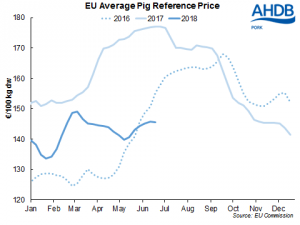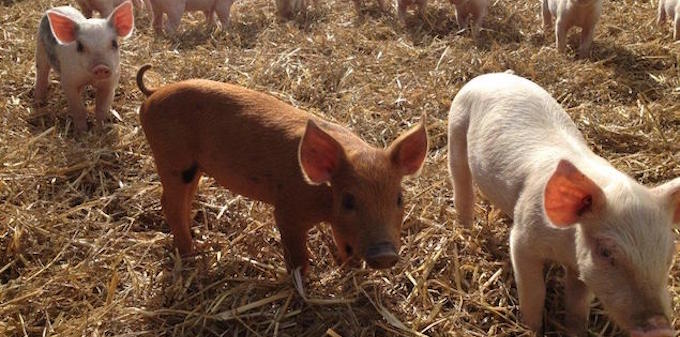During June, the EU pig reference price was edging upwards until the most recent week, when a small decline was recorded, AHDB Pork said. In the week ended June 24, the average price stood at €145.49/100kg, according to the EU Commission, which is a €2.37 gain on four weeks ago.
Prices in Spain have rocketed up in the past four weeks, gaining €7.70 over the period. Meanwhile, the Netherlands and Poland both recorded more modest price increases, of €1.65 and €2.60 respectively. Conversely, prices in both Denmark and Germany were broadly stable overall. The UK price has gained €2.20 since the end of May, to stand at €169.76/100kg.
As prices in Europe on average increased slightly quicker than UK prices, the premium received by UK producers narrowed slightly, to around €24/100kg. This is still above the five-year average. Prices in Sterling recorded a similar trend to in euros, due to the pound remaining fairly steady over the past four weeks. In sterling terms, the EU average pig price has gained £2.09 over the past four weeks, to 127.46p/kg.
Reports suggest supplies have somewhat tightened over the past few weeks which has helped support prices. This has likely been influenced by the recent warm weather, which tends to slow growth rates. In addition, the start of the tourist season in Italy and Spain may provide some boost to demand there.
However, in general, demand in Europe is reported to be below expectations, which may partly explain the fairly subdued seasonal rise in EU pig prices this year. An increase in demand for barbeque food in particular would typically support prices at this time of year.

The outlook for the coming weeks remains cautious, with demand in Northern Europe potentially negatively affected by the upcoming peak holiday season. Export markets are also reported to remain challenging.
Despite the recent price increases, over the past couple of weeks the difference between this year’s reference price and last year’s has remained reasonably steady, at around €31 lower. The summer peak therefore looks set to be significantly lower than in the past two years.




